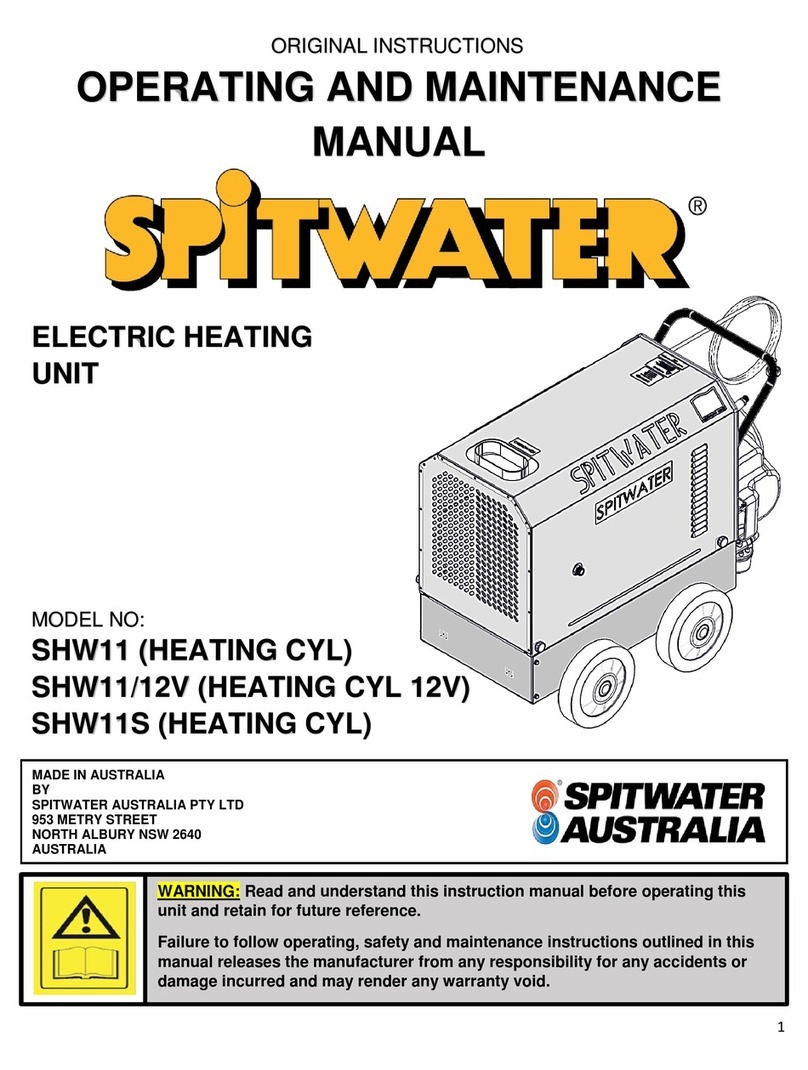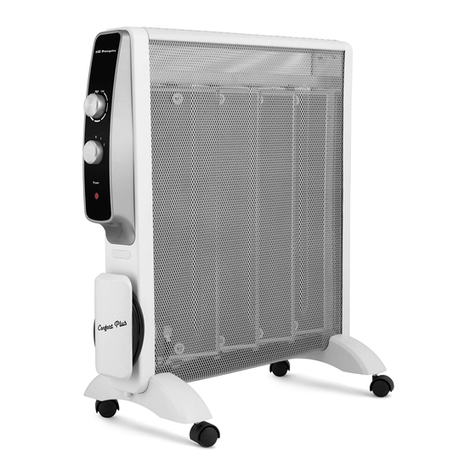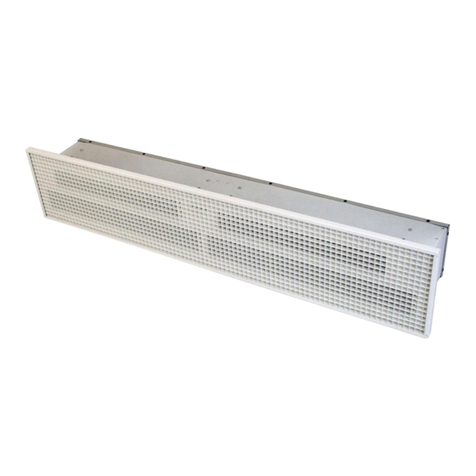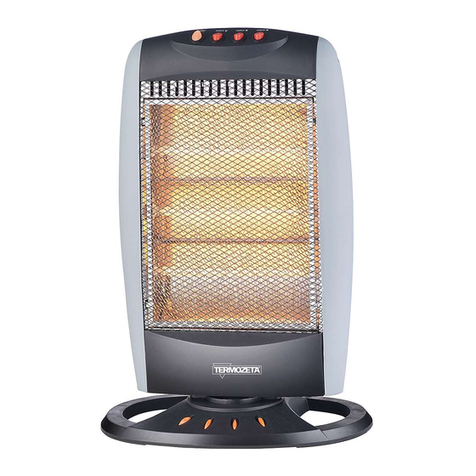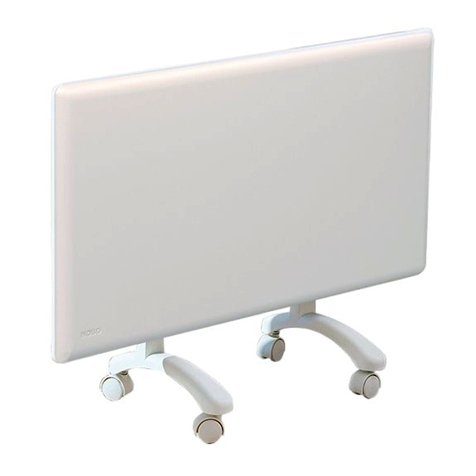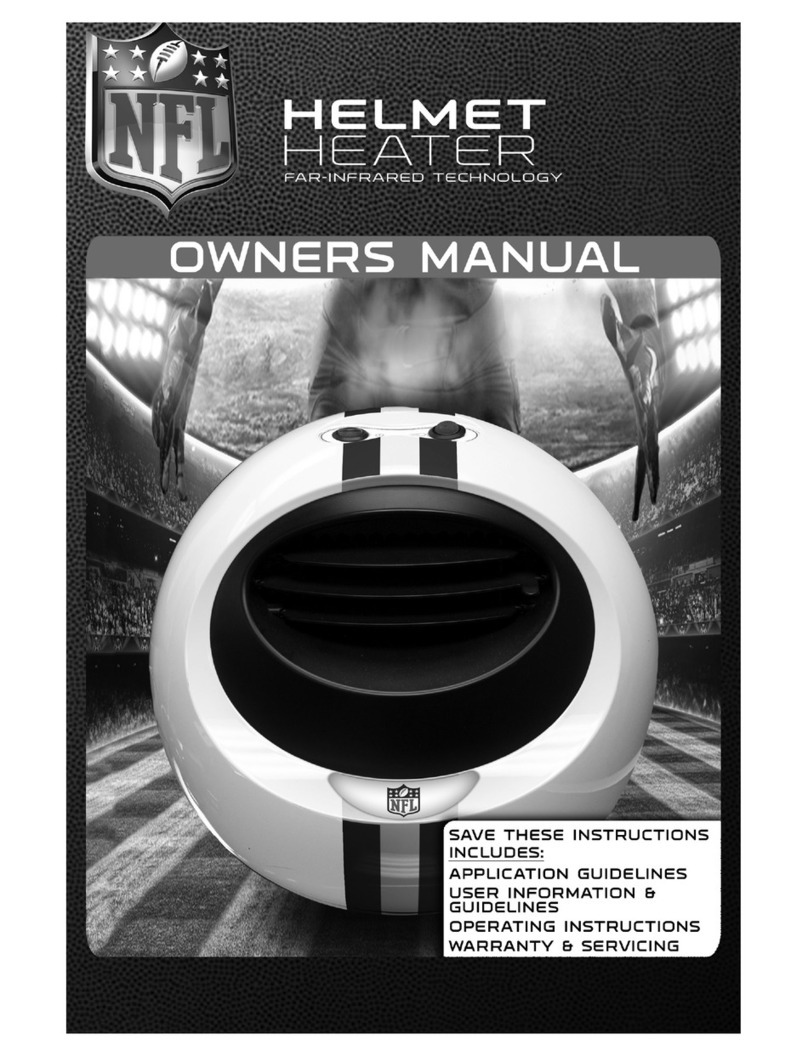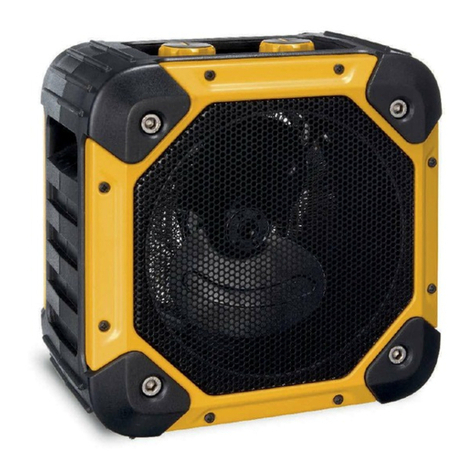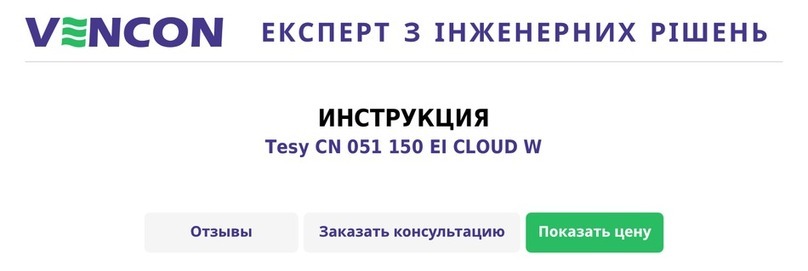Spitwater JETFIRE J20A Operating instructions

1
L-L 283.01-SW
ORIGINAL INSTRUCTIONS
OPERATING AND MAINTENANCE
MANUAL
J20A & J45A
Made in
Italy for:
Spitwater Australia Pty Ltd
953 Metry St
North Albury, NSW
Australia
WARNING:
THIS HEATER IS APPROVED FOR INDUSTRIAL USE ONLY.
Read and understand this instruction manual before operating this
unit and retain for future reference and pass on with the unit in the
event of a change of ownership.
Failure to follow operating, safety and maintenance instructions
outlined in this manual releases Spitwater Australia from any
responsibility for any accidents or damage incurred and may render
any warranty void.

2
L-L 283.01-SW
INTRODUCTION
Spitwater Australia is proudly Australian owned and operated since 1983. Our promise is to
provide our customers with superior quality portable industrial heaters built to the highest of
standards that will see many years of reliable service.
The JETFIRE range of portable industrial heaters are designed to give safe, efficient and
reliable service when the correct operating and safety instructions are followed, and proper
attention is given to all required maintenance procedures in order to maintain the unit in peak
operating condition.
This manual provides the up to date information necessary for the user to operate the unit and
carry out regular inspection and maintenance.
Please note that the information given within this manual may be subject to revision in
compliance with Spitwater Australia’s policy of continual improvement.
The JETFIRE range of heaters should only be used in the manner and purpose for which they
were intended
and in accordance with the recommendations and safety precautions detailed in this manual
and in operating instructions and stickers on the unit itself.
All JETFIRE heaters undergo rigorous safety and operational tests before being dispatched into
the marketplace however it is still imperative that prior to used, all operators have read and
understood all information and instructions provided and are aware of possible hazards.
GENERAL DESCRIPTION & INTENDED USE
Jetfire Heaters are specifically designed to solve all problems relating to heating drying and
desiccating in commercial and industrial applications. Some examples of applications are in
warehouse and factory heating, animal husbandry and greenhouse applications.
SPARE PARTS, ACCESSORIES & SERVICE
Spitwater has an extensive range of spare parts and accessories to suit all your heating needs.
For spare parts, accessories and service please refer to the contact section on
www.spitwater.com.au or contact 1800 SPITWATER (1800 774 892).

3
L-L 283.01-SW
TECHNICAL DATA
MODEL
J20A
J45A
PRODUCT CODE
JGDA020I
JGDA045I
UNIT
PERFORMANCE
HEAT OUTPUT
17.92
36.11
kW
FUEL PRESSURE – REGULATOR
70max/30min
150max/40min
kPa
FUEL PRESSURE – BURNER
70max/30min
150max/40min
kPa
NOMINAL GAS CONSUMPTION
65
130
MJ/h
MINIMUM ROOM VOLUME 350 850 M3
FUEL
FUEL TYPE
Universal
LPG
Universal
LPG
GAS CYLINDER SIZE
45
45
Kg
NOZZLE / INJECTOR SIZE
1.1
1.2
mm
ELECTRICAL
ELECTRICAL SUPPLY
230/1/50
230/1/50
V/~/Hz
CONNECTED LOAD
90
240
W
IGNITION TYPE
AUTOMATIC
AUTOMATIC
DIMENSIONS, WEIGHT AND OTHER
LENGTH
455/505
700
mm
WIDTH
277
317
mm
HEIGHT
500
538
mm
WEIGHT
9.5
16
Kg
MIN. DISTANCE TO COMBUSTIBLE MATERIAL
3
3
m
The manufacturer reserves the right to modify designs, features and technical data without
notice.

4
L-L 283.01-SW
DESCRIPTION OF SYMBOLS
The following symbols are used throughout this instruction booklet in order to mark important
paragraphs or sections that are due particular attention. Their meaning is listed next to them for
your attention.
WARNING
Failure to follow
instruction could
result in injury
or death
WARNING
Failure to follow
instruction could
result in damage to
machine
These are tips
and instructions
to ensure safe
and proper
operation
The following symbols are used on the machine in order to warn user of potential injury if not
cautious. Their meaning is listed next to them for your attention.
WARNING
Hot surface
Do not touch,
will result in
injury
WARNING
Electric shock
Disconnect power
before removing
cover
IMPORTANT SAFETY INSTRUCTIONS AND PRECAUTIONS
WARNING:
This heater shall only be used by persons instructed in its use and who have
been authorized to do so. Before using this heater please pay attention to the
following safety warnings as failure to do so could result in serious injury or
even death.
SAFETY LABELS
Always pay attention to the safety instructions provided on each label. Do not alter or
remove safety labels

5
L-L 283.01-SW
UNIT COMPONENTS, FEATURES AND CONTROLS
11
1 COMBUSTION CHAMBER
2BURNER
3COOLING FAN
4 HANDLE
5IGNITION ELECTRODE
6THERMOCOUPLE (M model)
7 IONISATION ELECTRODE (A model)
8RESET BUTTON
9HEATING SWITCH
10 ROOM THERMOSTAT PLUG
11 POWER CORD
IMPORTANT SAFETY INSTRUCTIONS AND PRECAUTIONS
GENERAL
•This heater must only be operated by persons instructed in its use
who have been especially authorized to do so.
•THIS HEATER IS APPROVED FOR INDUSTRIAL USE ONLY.
•NOT FOR DOMESTIC USE. Space heating only.
•DO NOT SPRAY AEROSOLS IN THE VICINITY OF THIS APPLIANCE WHILST IN
OPERATION
•DO NOT USE OR STORE FLAMMABLE MATERIALS IN OR NEAR THIS
APPLIANCE
•DO NOT MODIFY THIS APPLIANCE
•DO NOT PLACE ARTICLES ON OR AGAINST THIS APPLIANCE
•USE IN A WELL VENTILATED SPACE.
•Do not operate the heater if it is damaged.
•This heater must be positioned and operated on flat stable ground, not exposed to the
elements (rain, hail etc.) and must be operated in an upright position.
•Never leave the heater unattended while operating.
•Make sure you have read and understood the whole instruction manual before
installing, operating or carrying out any maintenance on the unit.
•Warnings and data plates on the unit provide important directions and information on
the safe use of the unit.

6
L-L 283.01-SW
•In addition to these operating and safety instructions, all accident prevention
regulations as well as any standards relating to the installation and operation of
heaters applicable in your country must be strictly followed.
•This unit is not intended for use by children. Children must always be supervised
when in the vicinity and ensure that they DO NOT play with the unit. Further, it is not
intended for use by persons with reduced physical, sensory or mental capabilities, or
lack of experience or knowledge.
•The heater is not to be installed in an area where there is a risk of fire or explosions;
•
Never operate this heater in basements or below ground level because of gas
stagnation.
•Do not use the heater on floors made with flammable materials.
•Do not store flammable materials in the vicinity of the heater (minimum distance: 3m);
•Ensure no overheating of walls, or ceilings made of flammable materials,
•Ensure all precautions have been taken to prevent fires;
•Ensure the premises in which the heater is installed are sufficiently ventilated for the
burner requirements; in particular, limits regarding air quality in the room to be heated
must conform to applicable laws;
•Ensure nothing is obstructing the aspiration and expulsion of air; movement of air may
be obstructed in various ways including placing covers or other objects on the heater
or positioning the heater too near a wall or other large object;
•Never direct the hot air flow from the heater towards the gas cylinder
•Ensure the heater is regularly monitored during operation and checked before being
started;
•Ensure at the beginning of each use, a check is made that the fan moves freely before
plugging the heater into the electrical power supply;
•Ensure at the end of each use, the mains switch is disengaged and supply power cord
removed, main gas stopcock is closed and gas tube disengaged and sealed.
1. GENERAL ADVICE
The heater must be installed, set up and used in accordance with the applicable
regulations and laws relating to the use of such equipment. Minimum distance from
surrounding walls and/or ceiling: 2m.
2. ELECTRICAL CONNECTION
•The voltage, hertz rating and number of phases on the data plate
must correspond to that of the electrical mains outlet that the unit is
being connected to.
•Only connect the unit to electrical installations made by certified
electricians and in keeping with local electrical regulations and
requirements.
•It is recommended that the electrical supply to this unit should include either a
residual current device that will interrupt the supply if the leakage current to earth
exceeds 30mA for 30 ms or a device that will prove the earth circuit.
•This Class 1 Appliance must only be connected to an earthed power supply fitted with
an appropriately sized fuse.
•The heater may be connected to a room thermostat by connecting to the thermostat plug
(10). Other accessories such as a timer may also be connected.
3. POWER CORD
•Make sure before every use that the power cord assembly
is not damaged or cut. If it is DO NOT connect the unit,

7
L-L 283.01-SW
have it replaced by an electrician or authorized service technician. (Type Y
attachment)
•DO NOT pull on the power cord in order to unplug the unit, remove the plug from the
power outlet.
5. EXTENSION CORD
•If using an extension cord, make sure it is a maximum length of 10
meters and sized according to cross section requirements as shown to
the right.
•Inadequate extension cords can be dangerous. If an extension cord is
used, it must be suitable for outdoor use and the connection must be
kept dry and off ground.
•Make sure the extension cord is fully unrolled, kept dry, away from
traffic, sharp edges and heat to avoid damage or cuts.
•If using an extension cord, make sure it is not connected to mains voltage when
connecting / disconnecting to the unit's power cord.
5. TRIP HAZARD
•Loose extension cords and power cables provide a potential trip hazard,
especially when they cross pathways.
•Take safety measures like placing traffic cones along the cord or tape the
cord to the floor with duct tape.
6. FIRE PREVENTION AND HOT SURFACE CAUTION
•Use only in areas free from flammable materials (flammable vapors,
high dust concentrations etc.)
•Keep combustible materials a safe distance from this unit (minimum
3m)
•An external guard should be place 1m away from the heater outlet to
prevent the approach of combustible material.
•Make sure firefighting equipment is readily available
•To avoid burns, be cautious of hot components like the chimney or the
Hot Air outlet and its vicinity.
•Do not under any circumstances restrict the air inlet or outlet of the unit. Always allow
a clearance of 3m in front (air outlet), 1 m above and behind (air inlet) and 600mm on
the sides.
•Do not operate this heater with the top cover removed.
7. EXHAUST & FLUE GASES
•Unit exhaust fumes (which contain carbon monoxide) can lead to death
if allowed to build up. Make sure the unit is operated in an area where
permanent ventilation to the ouside atmosphere is provided. Mandatory
minimum room size: 350 Meters Squared (M3)
•Allow a minimum room size as listed in the technical specifications.
•Ensure that any exhaust emissions are not in the vicinity of air intakes.
8. FUEL AND LUBRICANTS
•DO NOT smoke or allow flames or sparks in your work area. LPG is extremely
flammable and explosive under certain conditions.

8
L-L 283.01-SW
9. TRANSPORT
•Disconnect the unit from the power supply and allowe it to cool off before moving
between work areas.
•Always use the handle to lift and move the unit.
•If transporting the unit make sure it is appropriatly strapped to avoid hazards.
10.MAINTENANCE AND SERVICE
•The heater must be checked that it is safe and in proper working order
before putting into service and before every use. If the unit is damaged do
not use it.
•Always disconnect the unit from the power supply and allow it to cool off
before carrying out any inspection, service task or disassembling any part
of the heater.
•Never carry out any maintenance work not expressly outlined in this booklet and
never make any modifications to this unit.
•Never tamper with any settings of the unit (sealed or unsealed) and make sure that a
Spitwater authorized service agent carries out all servicing as required as this usually
include checking the correct functioning and setting of all safety devices as well as the
correct combustion of the unit.
•Always use original Spitwater spare parts when parts replacements are required.
•Inspect the unit each day before use. Follow “Daily inspection check list” guide Table-
Bin the Maintenance section.
•Service the unit regularly based on its usage. Follow “Usage vs Service frequency”
Table (Table-A) in the MAINTENANCE section. Always use a Spitwater authorized
service agent where requested to.
•Failure to follow the maintenance guidelines in this booklet releases Spitwater from
any responsibility in reference to injuries and damages to both persons and goods
and may also render any warranty given with the unit void.
ASSEMBLY, INSTALLATION, OPERATING AND STORAGE INSTRUCTIONS
INSTALLATION INSTRUCTIONS
Warning
All of the operations described in this section must be performed by skilled
personnel only.
POWER CONNECTIONS
Warning
Never attempt to switch the heater on or off by connecting the room thermostat
(or other control devices) to the electrical power line.
Installation and connection of room thermostat are described in the specific instructions
enclosed. The electrical diagram in this manual shows only the electrical connection of the
accessory to the existing electrical system of the heater.
Warning
Do not connect any air distribution hose: this will cause a severe fire hazard!

9
L-L 283.01-SW
CONNECTION TO GAS CYLINDERS
If the heater is run continuously on full output frost might form on the GAS cylinder indicating it is
starting to “FREEZE”. This condition is caused by excessive vapour withdrawal and can be
overcome by using various sizes of cylinders or multiple cylinder combinations.
To minimise the “FREEZING” effect we suggest the heater be connected to a minimum size and
quantity of Gas cylinders as follows:
•1 X 45KG CYLINDER (Minimum only – increase bottle size/number if using in low
temperatures)
UNDER NO CIRCUMSTANCES SHOULD THE HOT AIR FLOW FROM THE HEATER BE
DIRECTED TOWARDS THE GAS CYLINDER TO AVOID THIS “FREEZING.”
Warning
Propane Gas Cylinders must be installed and stored in accordance with current
local requirements. Propane Gas Cylinders should always be installed connected
and replaced in a flame free atmosphere. Use Propane vapour off-take cylinders
only.
Warning
All connections have left-hand threads, and must therefore be tightened by
turning anticlockwise.
The heater is supplied complete with gas hose (a) and pressure reducer (c) with fittings (d) for
connection to the gas cylinder.The connection supplied is AU ¼” BSP flare male inlet
connection.
Warning
The installer is responsible for ensuring the correct fitting is used for the
connection to the gas cylinder. Always tighten the cylinder fitting first, and
then the pressure regulator, which has a swivel fitting.
Warning
The seal of the fittings must be checked by pouring liquid soap on them: the
appearance of bubbles indicates a possible gas leak.

10
L-L 283.01-SW
Warning
Propane is heavier than air, therefore any gas leakage can cause gas stagnation
on the floor or in any underlying room.
A safety valve (b) may be ordered for protection in case of a damaged gas hose. Installation of
this valve is mandatory if required by local installation laws and regulations.
Warning
Always make sure that the seal (if required by the fitting) is present between the
reducer and the cylinder.
Make sure that the gas hose has been tightened without being twisted: any
stress from twisting can seriously damage the hose.
OPERATING INSTRUCTIONS
Warning
Before switching on the heater, check that the power supply specifications are
the same as those stated on the identification plate. Do not operate this
appliance before leak checking hoses and gas cylinder connection.
START
ALL MODELS
To start the heater:
• Set the pressure regulator to maximum pressure;
• Slowly open the gas stopcock on the gas cylinder;
Warning
In the case of a suspected gas leak, close the gas stopcock immediately, close
the gas cylinder valve, switch off the heater and unplug from the electricity
supply.
• Make sure the switch (9) is set to “0”;
• Turn on the switch on the main electrical panel;
A MODELS (with or without room thermostat connected)
• Move the heating switch (9):
• to position if room thermostat is not connected
• to position if room thermostat is connected and set it to a temperature higher than room
temperature
• Automatic starting cycle starts and light (8) flashes rapidly until the flame lights up.
If the heater still does not function, see TROUBLESHOOTING GUIDE” to identify the cause of
the malfunction.
To stop the heater:
To stop operation turn the thermostat adjustment down: the flame goes out and the fan motor
stops.
Close the gas supply stopcock and turn off the heating switch.

11
L-L 283.01-SW
Warning
If the heater is not used continuously, stop it by first closing the gas supply
stopcock and then switch it off or by turning down the thermostat this allows the
gas in the gas tube to be fully used and avoids any future leak when removing
the gas tube.
Warning
The reset button (8) may have different light types:
• light off: unit is working normally, flame is regular.
• fast flashing: unit is running on starting cycle.
• slow flashing: unit is in stand-by status, waiting for heating request.
• steady light: lock-out status.
TRANSPORTING AND HANDLING
The space heater can be lifted and moved easily by means of its handle.
Remove all or any packaging before use.
Warning
Before moving the unit:
• Stop the heater as indicated in the “STOP” paragraph;
• Disconnect the power supply by removing the plug from the power socket;
• Close the gas stopcock and disconnect the gas hose;
• Wait until the heater cools.
Warning
During transportation and/or storage, make sure the gas valve group and gas
connection pipes are not knocked or damaged in any way.

12
L-L 283.01-SW
MAINTENANCE
Warning
The operations described in this section must only be performed by authorized
personnel only.
The following procedures must be carried out at regular intervals to ensure efficient operation of
the heater. Ensure heater is disconnected from mains power before starting any work.
The Usage v Maintenance Frequency table below shows the regular maintenance required for
your heater, the maintenance interval and which maintenance can be done by the owner.
Interval
Maintenance Required
Done By
Every day
Check heater
Owner
Every day
Check gas supply line
Owner
Every week
Clean exterior of heater
Owner
Every week
Check electrical connections
Owner
Every 6 months
Clean motor & fan
Authorized service Agent
Every year
Clean burner & combustion chamber
Authorized service Agent
Table A
Time interval for checks and replacement listed above are for units subjected to normal
operating conditions. Should the unit be subjected to abnormal conditions (eg constant
use, extreme temperatures or conditions etc) times should be reduced accordingly.
Warning
Before carrying out any maintenance:
•Stop the heater as indicated in the “STOP” paragraph;
•Switch off the power supply by means of the cut-off on the electrical
panel;
•Wait until the heater cools.
1. CHECKING THE HEATER AND THE GAS SUPPLY LINE
Perform the following checks:
• Ensure heater is not installed where there may be a risk of fire or explosion
• Ensure flammable materials are kept a safe distance away
• If you smell gas:
• Open windows immediately
• Do not touch electrical switches
• Close the gas stopcock
• Find and repair the source of the gas leak
• Do not use the heater if any removed panels have not been remounted
• Ensure room to be heated is sufficiently ventilated

13
L-L 283.01-SW
• Ensure the air intake and outlet are completely unobstructed
• Ensure the heater is not covered by any sheets or covers
• Check that the heater is in a fixed and stable position;
• Ensure the heater is constantly monitored during operation and checked before being started;
2. CLEANING THE EXTERIOR OF THE HEATER
To ensure efficient operation, clean the following parts:
• Pipes, connectors and joints:
• Clean with a cloth.
• External body:
• Clean with a cloth.
• Air inlet/outlet:
• Remove all dirt and debris
• Make sure the air inlet/outlet are not obstructed.
3. CHECKING THE ELECTRICAL CONNECTIONS
After detaching the power cable, check all electrical connections as follows:
• Make sure that all connections are complete and tight.
• If there are traces of dirt or corrosion, contact authorised Spitwater service agent to clean and/or
replace the connections as necessary.
• Contact authorised Spitwater service agent replace any damaged wires or connectors if
necessary.
4. CLEANING THE MOTOR AND THE FAN (TO BE CARRIED OUT BY AUTHORISED
SPITWATER SERVICE AGENT ONLY)
Clean the fan blades and the motor as follows:
• Remove the fastening screws on the fan safety grille.
• Clean the motor with cloth or hard brush
• Clean the fan blades with a hard brush.
• Reinstall the safety grille.
• Close the side inspection panel

14
L-L 283.01-SW
5. CLEANING THE COMBUSTION CHAMBER (TO BE CARRIED OUT BY AUTHORISED
SPITWATER SERVICE AGENT ONLY)
To maintain the burner’s high efficiency and prolong its life, the procedure described in this
paragraph must be done at least once at the end of the work season or more frequently if there
is an excessive build-up of soot. Excessive soot may be caused by poor chimney draught, poor
fuel quality, poor regulation of the burner, or more or less frequent alternation of burner starts and
stops. Pay attention during operation: pulsations at start may be due to excessive amounts of
soot.
To access the combustion chamber:
• Remove the side inspection panel
• Clean with compressed air or a metal brush
• Reinstall the safety grille.
Warning
After any technical work, always check that the heater works correctly.
Warning
Incorrect cleaning of the heater can cause damage to property and/or people.
SERVICE/CARE RECOMMENDATIONS AND TROUBLESHOOTING GUIDE
To maintain this unit in peak working condition during its operating life it is necessary to carry
out regular maintenance operations and replace worn or broken parts immediately upon their
failure. The unit should never be operated if damaged. All checks, maintenance and servicing
other than procedures expressly outlined and authorized in this booklet are to be carried out
by an authorized Spitwater service agent using original spare parts. Ensure all servicing safety
precautions are followed and always isolate the unit from the electrical supply before carrying
out any maintenance or repairs.
For service please contact 1800 SPITWATER (1800 774 892) or refer to the contact section
on www.spitwater.com.au
Time interval for checks and replacement listed above are for units subjected to normal
operating conditions. Should the unit be subjected to abnormal conditions (eg constant use,
extreme temperatures or conditions etc) times should should reduced accordingly.

15
L-L 283.01-SW
OPERATOR INSPECTION AND MAINTENANCE CHECK LIST
Symbols meaning:
Unit is fit,
proceed
task
Do it yourself
refer to our
service tips
Do not use the unit. Contact
Spitwater authorised service agent
immediately
CHECKED AND OK
NEEDS ATTENTION
DAILY PRIOR TO STARTING THE UNIT
Ensure all guards, covers and shields are in place before operating the unit.
Check the power cable for any cuts, abrasions or damage.
Check fuel fittings and lines for leaks.
Check the unit is not damaged.
Check the fan blades rotate freely.
Check that all operator maintenance tasks or servicing has been done according
to Table-A
DAILY ON FIRST UNIT RUN
Check proper function of switches and temperature controller
Check color and smell of exhaust fumes. (Dark or smelly fumes= abnormal)
Table B

16
L-L 283.01-SW
TROUBLESHOOTING
FAULTS
CAUSES
REMEDIES
• The heater fails to start and
fan does not start
• No power supply
• Check power specifications
• Check power connections
• Contact Spitwater service agent
• Mains switch in wrong
position
• Select correct position
• Faulty operation of room
thermostat (A model)
• Check thermostat position
• Check thermostat electrical
connection
• Contact Spitwater service agent
• The heater fails to start
flame and stops while:
A MODEL >> lamp lights up
with steady red light
•Insufficient gas supply
• Check if gas bottle is empty
• Check gas supply line and
remove any debris inside
• Check pressure regulator and
replace if necessary
• Safety thermostat
tripped due to
overheating of
combustion chamber
• Check that the suction and the
flow grills are unobstructed
• Check that the room is well
ventilated
• Check that hot air can escape
freely
• Contact Spitwater service agent
• The flame does not light
up
• Check that the suction and the
flow grills are unobstructed
• Contact Spitwater service agent
• Faulty safety thermostat
• Check room thermostat and
replace it if necessary
• Contact Spitwater service agent
• Ionization electrode
does not detect a flame
(A model)
• Contact Spitwater service agent
• Control unit tripped due
to irregular burner
operation (A model)
• Contact Spitwater service agent
• Faulty electronic control
unit (A model)
• Contact Spitwater service agent
• The heater does not stop
when "STOP" procedure is
followed
• Gas solenoid valve does
not close because of
debris
• Close main gas stopcock on
gas bottle, let the heater
burn remaining gas in gas tube,
and contact Spitwater service
agent
• Faulty room thermostat
(A model)
• Check room thermostat and
replace it if necessary
• Check electric connection of
room thermostat
• Contact Spitwater service agent
• Fan noise or vibrations
• Foreign bodies on fan
blades
• Contact Spitwater service agent
• Insufficient air
circulation
• Eliminate all possible obstacles
to proper air flow

17
L-L 283.01-SW
SAFETY DEVICES
Space heaters are direct-combustion and forced convention units. Air is heated by the thermal
energy generated during combustion and is then conveyed to the room to be heated along with
the combustion products: the room MUST be suitably ventilated to ensure adequate air
circulation. Various safety devices trip in the event of serious malfunction:
Temperature Limit Control:
This heater is equipped with a Temperature Limit Control / overheating thermostat LI designed to
turn off the heater should the internal temperature rise to an unsafe level. If this device activates
and turns the heater off, it may require service.
Electrical System Protection:
The heater's electrical system is protected by a fuse mounted to the PCB assembly that protects
the system components from damage. If the heater fails, check the fuse first, replace if necessary.
Flame-Out Sensor:
The electronic burner control unit trips if the flame is irregular or goes out: in Automatic heater
models the reset button (8) lights up with a steady red light.
In each of the cases described above, the space heater stops working in lock-out condition.
The cause of the malfunction must always be investigated and eliminated before starting the
heater again. Refer to ‘TROUBLESHOOTING guide contained within this manual for advice
and if in any doubt, contact your authorized Spitwater service agent. Note the heater can
restart only if reset button (8) is pressed (red lamp is off).

18
L-L 283.01-SW
Wiring Diagram
C Capacitor
MV Fan motor
FUA Fuse
RV Switch
PR Reset switch
LI Overheat safety thermostat
AP Control box
TA Room thermostat plug
EV Gas solenoid valve
RP Resistence
PA Air pressure switch
EL Ionisation electode
This manual suits for next models
1
Table of contents
Other Spitwater Heater manuals
Popular Heater manuals by other brands
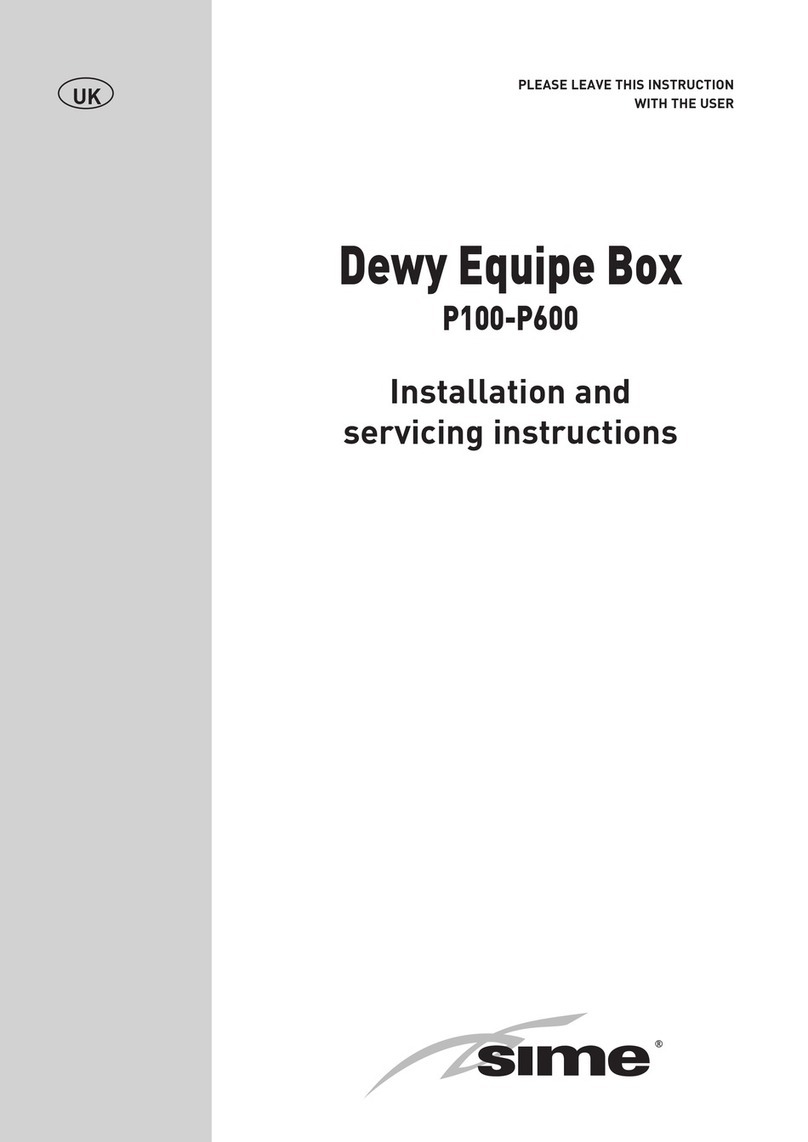
Sime
Sime Dewy Equipe P100 Box Installation and servicing instructions
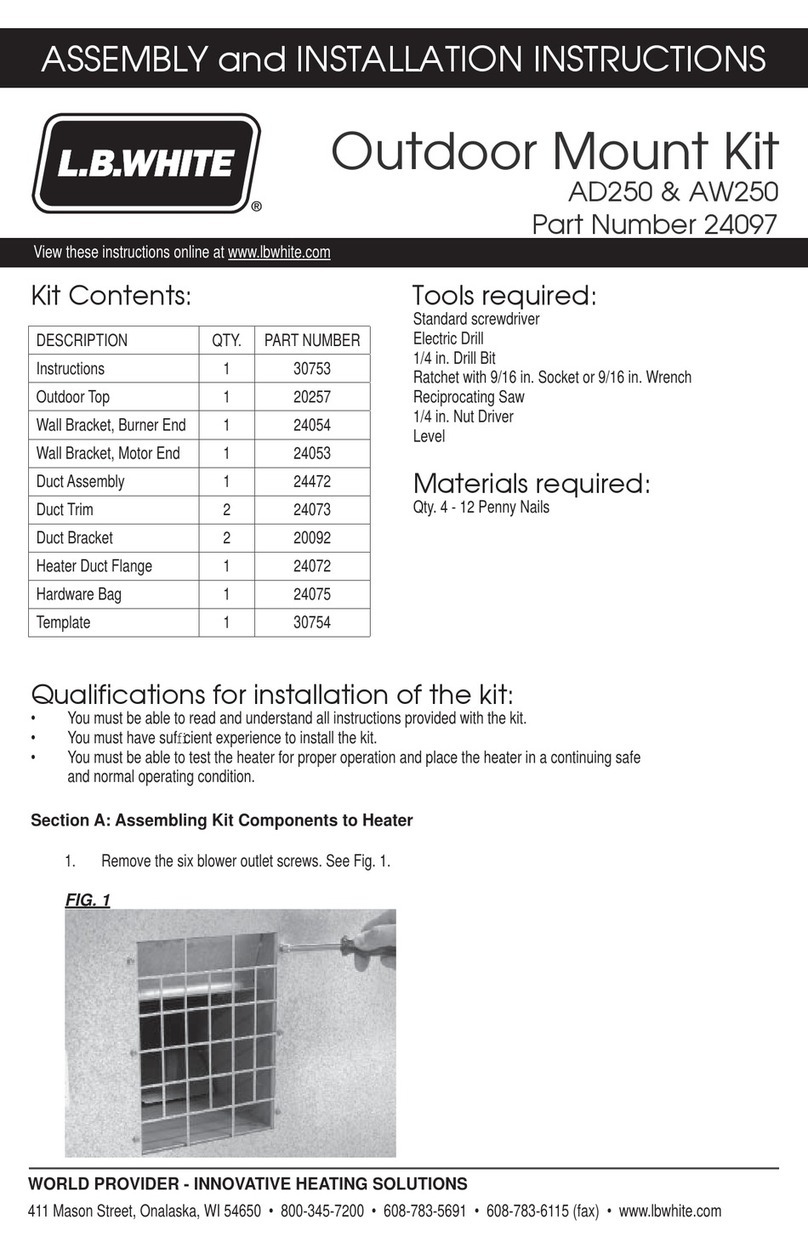
L.B. White
L.B. White GUARDIAN Smart Sense AD250 Assembly and installation instructions
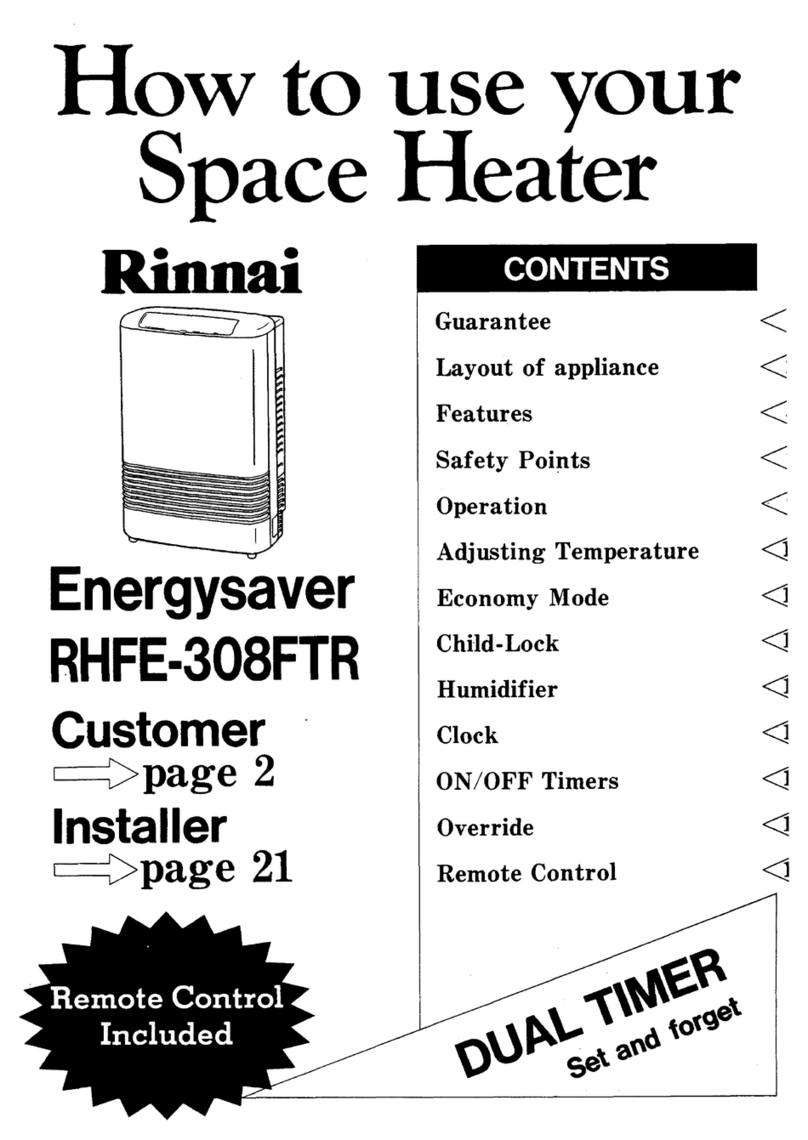
Rinnai
Rinnai ENERGYSAVER RHFE-308FTR How to use

Suntec Wellness
Suntec Wellness Klimatronic Heat Safe 1000 PTC-Turbo manual
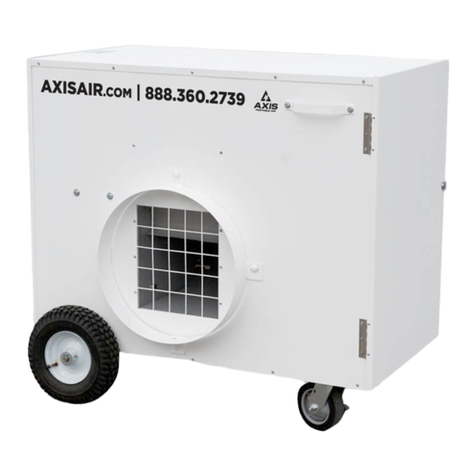
Flagro
Flagro THC- 355CDF Operating instructions manual
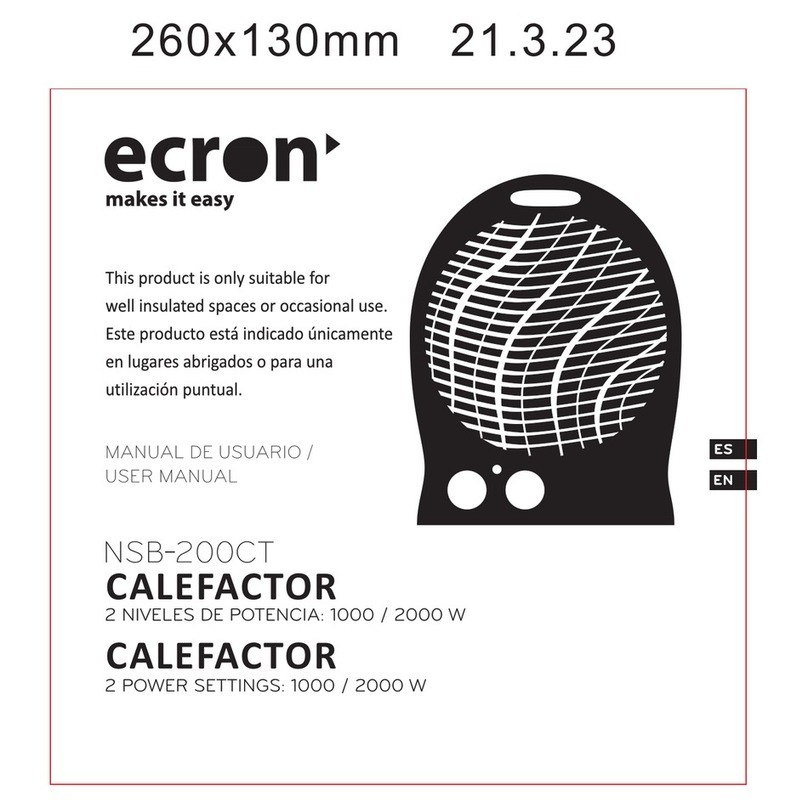
ECRON
ECRON NSB-200CT user manual
